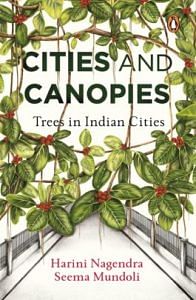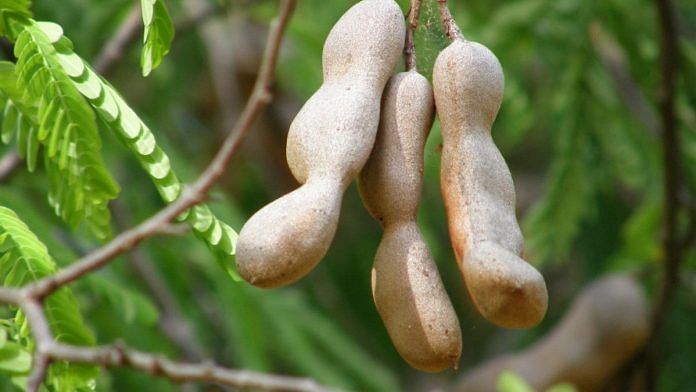Tamarind trees can tell many tales of adventure and intrigue. In 2004, it was under the shade of a tamarind-lined avenue on Akbar Road in New Delhi that agitators collected to put pressure on Sonia Gandhi to take up the post of prime minister after the Congress’s election victory. One protester is said to have climbed a tamarind tree, refusing to come down unless his demand was met.
Even after the issue was resolved, with Sonia Gandhi saying no to the post of prime minister and the crowd finally accepting her decision, a few men continued to perch on the trees. This unlikely hero is so much a part of Indian culture, particularly Indian food, that many of us will be surprised to find out it is a firangi (a foreign import).
The scientific name of the tamarind is Tamarindus Indica. The name ‘indica’ leads to the common misconception that the tree originated in India. But in this, the tree has us fooled. It came not from India, but from far-off central Africa, where it was called the ‘tree of life’.
Also read: Why covering the environment is one of the most hazardous beats in journalism
The tamarind made its way to India millenniums ago. Wood charcoal analysis shows us that the tamarind was found in Narhan, in the Ganga valley, by 1300 BC, and also in the pre/early Harappan period in Haryana. The Brahma Samhita scriptures, dating back to between 1200 BC and 200 BC, also talk of the tamarind. Down south, a copper plate inscription of 819 AD mentions a tamarind tree named Mahamadhu—perhaps a tree with large beehives? We will probably never know, but it is fun to speculate.
The Arabs, who had trade relations with India as early as 600 AD, loved the tree as much as we do in India. They gave it the name Tamar-i-Hind (date fruit of India) because of the brown fruit that resembled dates. It is believed that the species name, ‘indica’, was given by Linnaeus, from this derivation in Arabic. The Arabs traded in the fruit, taking it to European and Arabian countries.
The genus Tamarindus has only one species—the tamarind that we all know. The tree is never really without leaves, though during the dry season it may be scantily covered. But it looks most beautiful when fresh, tender leaves appear with the onset of the monsoon. We don’t usually pay attention to its flowers, which are quite tiny and a pretty creamish-yellow. There is a very interesting behaviour that the leaves display. If you look carefully, you will see the leaves are open during the day, but fold as soon as the sun sets.
This behaviour fascinated Alexander the Great and his team. Androsthenes, a Greek admiral who was sent by Alexander on military expeditions, recorded this strange movement of the leaves of a tamarind on the island of Tylos, which we now know as Bahrain, in the fourth century BC. Many flowering plants show similar behaviour—their leaves or flowers close at night and reopen in the sunlight, a phenomenon with the long and complicated name of nyctinasty. At the bottom of the compound leaf of the small tamarind lies an even tinier organ called the pulvinus. Water rushes in and out of different parts of the pulvinus at dawn and sunset, leading to small changes in pressure at the bottom of the leaf, which press it closed at night, opening it again at dawn. We know how the tamarind closes its leaves (well, at least partially. The chemical details, however, are still not fully known to scientists). But why does it go to all this effort? This still remains a mystery, despite science having progressed in the millenniums since Alexander’s great march.
Also read: Introducing biotech trees to help stop disappearing forests is easier said that done
We may not know why the tamarind sleeps at night. But (and perhaps more to the point) we do know how to use it. Almost every part of the tamarind tree has some value. The sour fruits are high in calcium and can be made into pickles or chutneys. Ripe tamarind pulp is of course widely used in Indian cooking, in a variety of dishes.
Some communities also use the flowers. In Latin America, the ripe pulp is sweetened with sugar and made into a popular local drink called tamarindo. The British use the pulp to make their famous Worcestershire sauce. But the fruits and flowers are not used in festivals or ceremonies as they are considered too sour to be auspicious. The acidic pulp is much in demand in homes, used to clean tarnished brass, bronze and silver vessels (as well as much valued idols and lamps). The tree’s tender leaves are rich in vitamin C and very tasty—they can be made into chutneys, added to sambar, or chopped into chapatti batter. Mangaloreans even have a traditional recipe for roasted tamarind seeds (pulinkote), eaten after removing the hard coat. Be careful if you try this at home—this requires strong teeth and you may crack yours if you are not careful. The seeds have other traditional uses. In Tamil Nadu, a folk performance called koothu, performed by the Kaniyan community, uses drums called makudam. These drums are made by pasting leather to a wooden frame, using glue made from tamarind seeds. In Bengal, a powder made from the seeds is used by master craftsmen, who mix these with powdered colours at very high temperatures and use the resulting varnish and colours to paint idols.
Tamarind wood has its uses too. It is termite-resistant and hardy, and sought-after in cities as fuel. It can be used to make furniture as well, and charcoal produced from the wood can be used to make gunpowder. The wood was once used as fuel for gasogens or wood gas units, which converted wood or charcoal into gas, and powered Indian vehicles during WWII.
Also read: 33 years after nuclear explosion, Chernobyl has become a wildlife paradise
In its original home of central Africa, the tamarind occurs naturally in dry savanna woodlands. The Senegalese capital, Dakar, is named after the local name for tamarind which is dakhar. But the tree has now spread across the world and is grown in fifty-four countries. Not surprisingly, India is the world’s largest producer of tamarind. one of the oldest man-made tamarind groves is the Nallur Amarai grove, close to the international airport in Bengaluru. This is a massive grove of trees, covering a little over 53 acres. Some of the trees are believed to have been planted during the reign of the Chola dynasty, several hundred years ago. The grove was protected by special watchers appointed by the British government, who also planted additional trees here. In 1887, the grove had fifty-five big and 342 large tamarind trees, and provided a source of revenue for Bengaluru. It now has over 300 trees. Carbon dating has found that the oldest tree here is over 400 years old. The old trees have a unique feature. They bear prop roots, which look like that of the banyan—roots that emerge from the trunk to provide support. The Nallur Amarai grove is famous across India. It is the first biodiversity heritage site to be declared in the country.
The tamarind has been a popular roadside tree for centuries.
The tree was a favourite with the Mughal rulers. Babur, who established the Mughal Empire in India, described the tamarind as a ‘very good-looking tree, giving dense shade’ in Babur Nama. In Akbar’s time, the fruit (called ambli) was economically valued and sold in the market. Tamarind trees were planted by the Mughals in cemeteries and mausoleums, and around settlements. A particularly iconic tree was planted at the tomb of Tansen (the incomparable musician who formed a key part of Emperor Akbar’s court) in Gwalior, visited by musicians who wished to pay homage. This was a double-edged blessing. Sher Shah Suri and Jahangir planted trees along Grant Trunk Road, favouring a mix of the tamarind and mango, to provide shade and fruit to weary travellers. The nawabs of Avadh also planted the tree along main roads in their kingdom. In a village in Bijapur, an 890-year-old tamarind tree planted during the time of King Adil Shah still survives.
 This excerpt from Cities and Canopies: Trees in Indian Cities has been published with permission from Penguin Random House India.
This excerpt from Cities and Canopies: Trees in Indian Cities has been published with permission from Penguin Random House India.



